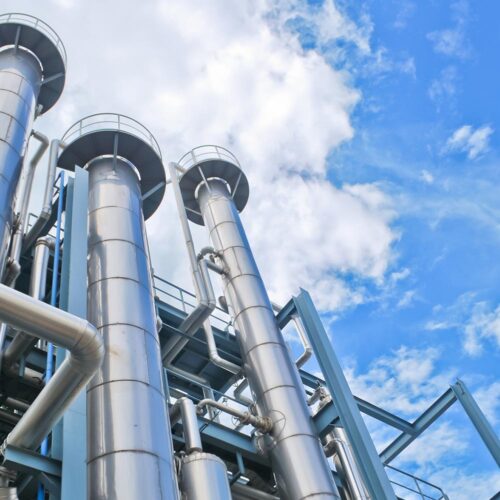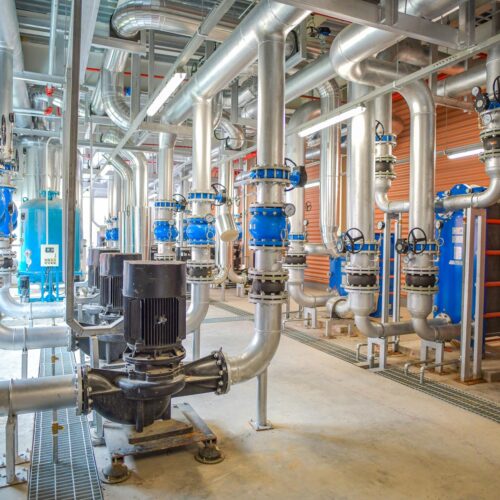
Exploring Three Business Models for Industrial Heat Pump Manufacturers
How industrial heat pump manufacturers can connect with customers to demonstrate value and build partnerships to create market momentum.
The industrial heat decarbonization sector is at a pivotal moment. Global climate goals demand significant emissions reductions, yet the path to decarbonizing industrial processes remains fraught with challenges. At the heart of this transformation lies a fundamental truth: business models are not static choices but dynamic systems that evolve in response to market needs. For industrial heat pump original equipment manufacturers (OEMs), this evolution is not just about technology — it’s about forging the right partnerships, understanding customer needs, and aligning revenue strategies to scale impact.
This article explores three business models that represent different stages in the process: technology provider, development solutions provider, and turnkey partner. Industrial heat pump OEMs may choose one model or evolve between them. Each model involves unique activities, partnerships, customer relationships, and revenue models that drive progress. By breaking down these stages, we highlight the flexibility and strategic decisions needed to navigate this transformation successfully.
The starting point: Direct OEM-customer connections
In the industrial heat decarbonization space, OEMs will mostly likely have to lead the charge in building customer demand — the foundation for any business model. Engineering, procurement, and construction firms (EPCs) and integrators, while crucial partners, are typically technology agnostic and respond to established customer needs. In the absence of widespread demand, it usually falls to OEMs — driven by their mission and innovation — to make direct connections with customers. These early, one on one relationships are the foundation upon which partnerships, market presence, and business models grow. To all proponents of decarbonized, electrified industrial heat: now is the time to help these OEMs build demand.
Evolutionary paths: Flexibility between bookends
While this article outlines three distinct models that represent different stages, it’s important to note that these stages are not rigid steps, but flexible paths shaped by market dynamics. Some OEMs may choose to remain specialized technology providers, deepening their collaboration with integrators and EPCs. Others may pursue the turnkey provider model, integrating vertically to deliver comprehensive solutions. Most will chart a course between these bookends, adapting their strategy to meet customer needs and market opportunities.
Technology provider: Pioneering technology and building market awareness
In the early stage, the OEM's mission is clear: bring innovative technology to market and find its first adopters. This stage is often marked by a lack of customer demand, requiring OEMs to take the initiative in creating awareness and building trust.
Key Activities
- Developing and refining the heat pump technology to meet industrial specifications.
- Conducting bespoke pilot projects and demonstrations to prove technical viability.
- Educating potential customers about the benefits of industrial heat pumps.
Partnerships
- Research Institutions and Funding Bodies: These partnerships provide technical expertise and financial support, allowing the OEM to refine its technology without overextending internal R&D resources. Outsourcing this ensures access to cutting-edge research and non-dilutive capital.
- Small Engineering Firms: Engineering partners assist with integration and technical support for pilot projects. This avoids the need for the OEM to build costly, in-house integration teams at a stage when resources are limited.
- Environmental Organizations: Validating emissions reductions through external bodies builds credibility, leveraging their reputations to overcome customer skepticism.
Customers
- Early adopters, often companies with strong sustainability goals or those incentivized by regulations. These early adopters are more willing to accept the uncertainty of new technology due to their incentives.
Revenue generation
- Revenue primarily comes from direct equipment sales, supported by pilot project funding or grants.
- OEMs may offer discounted pricing or shared risk models to incentivize early adoption.
Critical decisions
- Customer Engagement Strategy: Deciding which industrial sectors to target first and prioritizing early adopters who can validate the technology. Just as importantly, deciding when to move on because the customer does not have sufficient risk tolerance.
- Boots-on-the-Ground Timing: Strategizing when and how frequently to deploy limited resources for direct engagement with the industrial facility to co-develop the integration and execution plan.
- Partnership Formation: Choosing the right collaborators, such as small engineering firms capable of high-value engineering, to address design and integration challenges.
Development solutions provider: Scaling operations and creating standardization
As the OEM gains traction, the focus shifts to scaling operations and broadening the customer base. Customer demand starts to grow and success demands on standardizing deployments and reducing costs. At this stage, OEMs must strike a fine balance between expanding in-house capability and cultivating more external partnerships.
Key activities
- Expanding manufacturing capabilities to support higher production volumes.
- Developing standardized solutions to streamline deployment across diverse industries.
- Investing in sales and marketing to penetrate new markets and industries.
- Expanding the internal team to add capability in project execution and/or capability in vetting and selecting the right partners for the right phase of the project.
Partnerships
- Mid-Sized EPC Firms: These firms manage project integration and deployment at scale. Collaborating with them enables the OEM to serve more customers without overburdening internal resources or building expansive deployment teams.
- Risk Tolerant Financial Partners: Leasing or financing options lower adoption barriers for customers and partnering with financial institutions ensures the OEM doesn’t bear the full risk.
- Government Bodies and Industry Associations: These partnerships provide access to policy incentives and help the OEM navigate regulatory landscapes, reducing market entry barriers.
Customers
- Increased focus on educating procurement teams and decision makers at target companies leading to broader adoption by mid-sized industrial players seeking cost-effective decarbonization solutions.
Revenue generation
- Equipment sales remain significant, but service contracts and maintenance agreements start contributing.
- OEMs may begin to explore heat-as-a-service models, offering customers performance-based agreements that reduce up-front costs and share savings from energy efficiency improvements.
Critical decisions
- Standardization vs. Customization: Balancing the need for standardized solutions to scale with the ability to meet site-specific needs.
- Financing Models: Introducing new financial structures, such as leasing or heat-as-a-service, to make adoption more accessible for mid-sized industrial players.
- EPC Engagement: Deciding whether to deepen partnerships with EPC firms or bring more integration capabilities in-house.
Turnkey partner: Comprehensive solutions and market leadership
In the mature stage, the OEM evolves into a market leader, capable of delivering turnkey solutions. This stage is characterized by advanced capabilities, streamlined processes, and robust customer relationships.
Key activities
- Offering end-to-end project delivery, from design to commissioning and ongoing support.
- Leveraging digital tools for monitoring, optimization, and predictive maintenance.
- Expanding globally to serve multinational customers with complex needs.
Partnerships
- Large-Scale EPC Firms: For complex, multi-site deployments, these partners bring the project management expertise needed to execute efficiently, allowing the OEM to focus on strategic oversight.
- Project Finance Providers: Establishing strategic long-term partnerships with financial institutions for heat-as-a-service project finance and exploring arrangements to pool risk for multiple projects under one financial vehicle.
- Technology Providers: Advanced controls and digital integration enhance the heat pump’s performance and customer value, making partnerships with software or IoT firms critical.
Customers
- Risk-averse large industrial players and multinational corporations with ambitious decarbonization targets that have been waiting to see successful implementation of the technology in their specific application areas before moving to adopt the technology themselves.
Revenue generation
- Maintenance and digital optimization services add value and deepen customer relationships.
- Heat-as-a-service may become a dominant revenue model, creating recurring income streams tied to energy savings and emissions reductions.
Critical decisions
- Turnkey or Specialist: Determining whether to fully embrace the turnkey provider model or remain focused as a technology OEM that partners with established integrators.
- Global Expansion: Deciding when and how to enter international markets, accounting for regional decarbonization policies and industrial needs.
- Long-Term Contracts: Committing to heat-as-a-service agreements that require advanced financial and operational capabilities.
Embracing evolution to drive decarbonization
By starting with direct customer engagement and building from there, OEMs can navigate the complexities of scaling technology, forging partnerships, and creating sustainable revenue models. Whether choosing to specialize or expand into turnkey solutions, the key is to remain adaptable and mission driven.
The industrial heat decarbonization sector is at a pivotal moment, and OEMs are at the forefront of this transformation. By embracing their role as market creators and evolving their business models strategically, they can accelerate the shift to a low-carbon future — one heat pump at a time.


